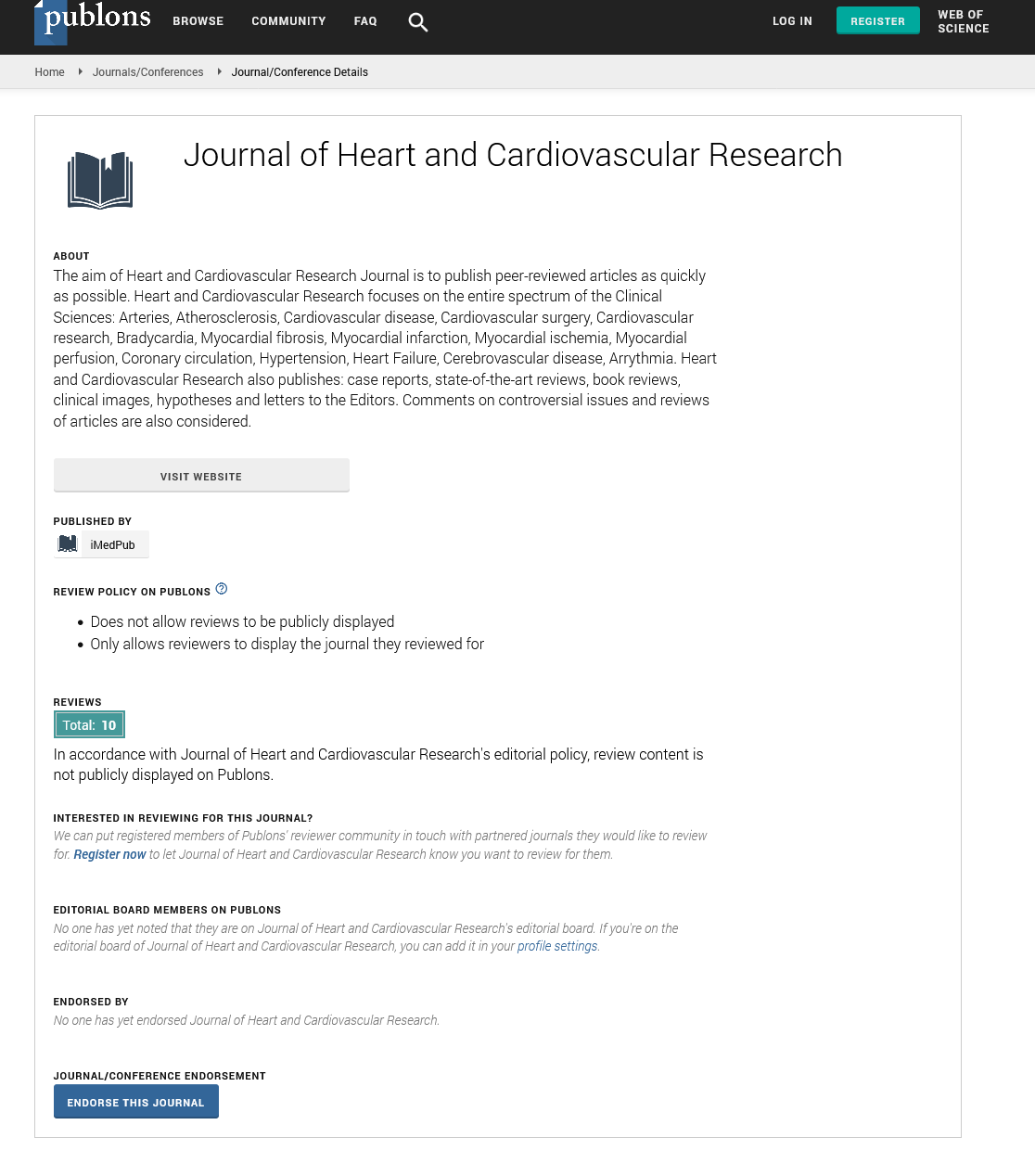ISSN : ISSN: 2576-1455
Journal of Heart and Cardiovascular Research
Abstract
Adenosine Attenuates cAMP-Dependent Chloride Current In Isolated Guinea-Pig Ventricular Mycocytes.
Introduction:
the present study was aimed at testing the hypothesis that adenosine can attenuate catecholamines/cAMP-dependent ICl in ventricular myocytes by activating A1AdoR and a PTX-sensitive G protein(s). The present data support this hypothesis and suggest that the attenuation of ICl by Ado is another important manifestation of the antiadrenergic action of the nucleoside on the guinea pig ventricular myocardium.
Objectives:
The modified Krebs-Henseleit (K-H) solution contained (mM): 127 NaCl, 4.6 KCl, 2 CaCI2, 1.1 MgSO4, 2 sodium pyruvate, 10 glucose, 10 creatine, 20 taurine, 5 ribose, 0.01 adenine, 0.1 allopurinol, and 5 HEPES. The composition of the Ca2+- free solution was the same as that of the K-H solution except for the deletion of CaCl2 as extracellular solution. pH was adjusted to 7.4 with NaOH and the osmolarity was 310 mOsmol. The intracellular solution consisted of (mM): 120 CsCl, 20 NaCl, 2 EGTA, 1 Mg-ATP and 10 HEPES. pH was adjusted to 7.2 with CsOH and the osmolarity was 305 mOsmol. The following chemicals were used: Adenosine, N6- cyclopentyladenosine (CPA), a selective adenosine Aâ‚Âàreceptor agonist, 8-cyclopentyltheophylline (CPT), a potent and selective antagonist for the adenosine receptors, isoproterenol (ISO), forskolin (stock solution 23.3 mM in DMSO), Na-glutamate, a replacement of NaCl, nifedipine, to block Ca2+ currents, BaCl2, to block inward rectifying K+ current, TTX, to minimize rapid Na+ activation, bovine serum albumin, dispase (Boehringer Mannheim, Indianapolis, IN), collagenase (Worthington Biochemical Co., Freehold, N.J.) , trypsin, and PTX (Calbiochem Corp. San Diego, CA). Unless otherwise specified, all compounds were from Sigma-Aldrich, Inc. (St Louis, MO)
Results:
A typical example of current recordings under whole-cell voltage clamp in an isolated guinea-pig ventricular myocyte is shown in .This conductance, which was a non-voltageactivated and without rectification, had a reversal potential near 0 mV when [Cl-]o was approximately equal to [Cl-]i. Both Ado and A1AdoR agonist CPA markedly attenuated the ISO-induced current; this inhibition was partially reversed by the A1AdoR antagonist CPT . The induction of anion conductance by ISO was mimicked by forskolin, which activates adenylyl cyclase. Ado also inhibited the forskolin-induced current . Forskolin carrier alone had no effect (data not shown). CPA, a selective adenosine receptor agonist, also can reverse the effects of ISO and forskolin .The effects of Ado on ISO and forskolin are shown in the current vs. voltage curves in Figures 2a and 2b. Ado’s current inhibition had a relatively quick on-set occurring within one minute or less. Further characterization of ISO-induced conductance indicated that it was similar to cAMPactivated- conductance described previously .Replacement of NaCl in the bath perfused with Na-glutamate, reduced [Cl-]o from 156.8 mM to 16.8 mM while maintaining the original cation concentrations. The reduction of [Cl-]i shifted the zero current potential of the I/V curve in the positive direction by ~30 mV indicating a significant Cl- selectivity of the channel . Similar results were obtained in additional four myocytes. Extracellular glutamate also decreased the slope inward current indicating reduced Cl- efflux .Similar reduction of cAMP-activated conductance has been reported when aspartate replaced extracellular Cl- Thus, the substitution of [Cl-]o with nonpermeant glutamate or aspartate seems also to produce a partial block of Cl- flux through the chloride channel, which is manifested as reduced inward current.
Conclusions: In summary, the present data indicate the Ado suppresses catecholamine/cAMP-dependent chloride conductance in guinea-pig ventricular myocytes and that this action is mediated by A1AdoR and a PTX sensitive G protein(s). Multiple chloride channels modulated by various signals including stretch, calcium, and phosphorylation have been characterized in human myocardium . However, cAMP-dependent chloride conductance has not been demonstrated in human myocardium heretofore. Thus, the clinical significance of the present characterization of another aspect of the anti-adrenergic action of Ado as another aspect If Ado’s cardio-protective mechanism remains to be determined.
Author(s): Jiang Xu, Qi-Hua Gong, Steven J. Wieland and Amir Pelleg*
Abstract | PDF
Share This Article
Google Scholar citation report
Citations : 34
Journal of Heart and Cardiovascular Research received 34 citations as per Google Scholar report
Journal of Heart and Cardiovascular Research peer review process verified at publons
Abstracted/Indexed in
- Google Scholar
- Sherpa Romeo
- China National Knowledge Infrastructure (CNKI)
- Publons
Open Access Journals
- Aquaculture & Veterinary Science
- Chemistry & Chemical Sciences
- Clinical Sciences
- Engineering
- General Science
- Genetics & Molecular Biology
- Health Care & Nursing
- Immunology & Microbiology
- Materials Science
- Mathematics & Physics
- Medical Sciences
- Neurology & Psychiatry
- Oncology & Cancer Science
- Pharmaceutical Sciences
